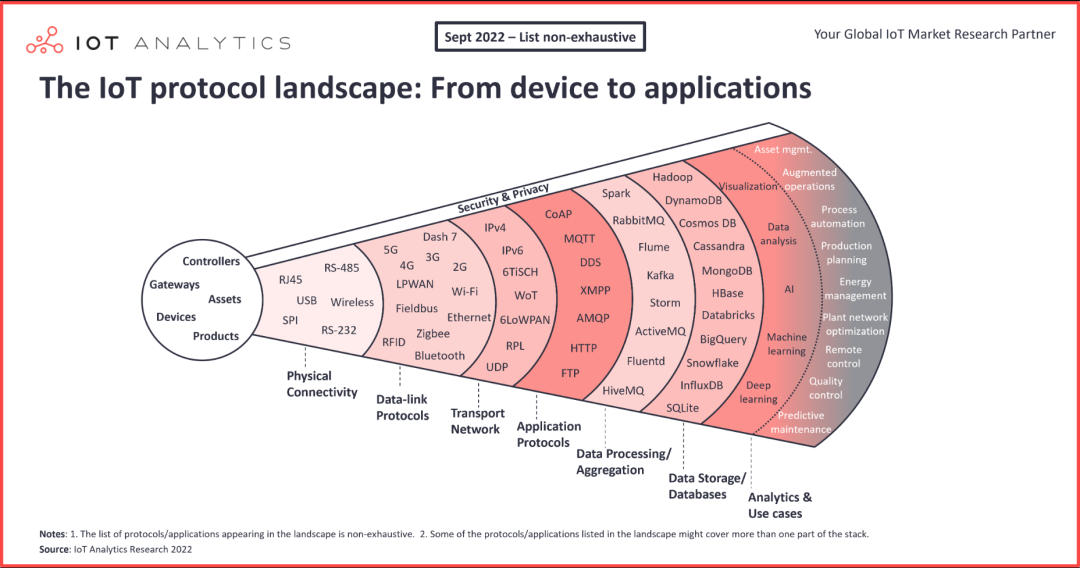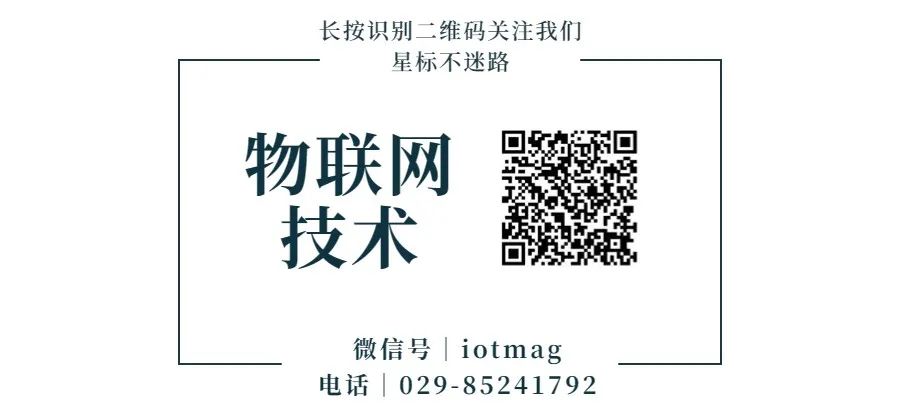
IoT protocols refer to the protocols used for communication and data transmission between devices in an IoT environment. Based on their functions, IoT protocols can be categorized into Transport Protocols, Communication Protocols, and Industry Protocols.
-
Transport Protocols: Generally responsible for networking and communication between devices within a subnet. Examples include Wi-Fi, Ethernet, NFC, Zigbee, Bluetooth, GPRS, 3G/4G/5G, etc. These protocols ensure the security and reliability of data transmitted over the network.
-
Communication Protocols: Mainly run on top of the traditional Internet TCP/IP protocol for device communication, responsible for data exchange and communication between devices over the Internet. Examples include MQTT, CoAP, HTTP, etc.
-
Industry Protocols: Standard protocols unified within a specific industry. For example, vehicle networking JT/T808, video GB/T 28181, etc.
01
Transport Protocols
| Protocol | Protocol Description and Application Scenarios |
| Modbus | Protocol Description: Modbus is an application layer message transmission protocol that includes three message types: ASCII, RTU, and TCP. Through this protocol, controllers can communicate with each other and with other devices via the network (e.g., Ethernet). Application Scenario: Widely used in the industrial field. |
| OPC-UA | Protocol Description: Full name is OPC Unified Architecture, an open-source, platform-independent standard protocol; through this protocol, devices using different systems can send messages for communication between clients and servers over the network. Application Scenario: Suitable for manufacturing software in fields like field devices, control systems, manufacturing execution systems, and enterprise resource planning systems. |
| OPC-DA | Protocol Description: OPC-DA is suitable for single-system data access. It defines standards related to data values, update times, and data quality information. Application Scenario: Suitable for data exchange between devices from multiple vendors and control applications. |
| LoRa | Protocol Description: LoRa is a low-power local area network wireless standard developed by Semtech, which solves the technical problem of achieving longer transmission distances under the same power consumption conditions, unifying low power consumption and long distance. Application Scenario: Mainly used in smart cities, smart buildings, smart homes, smart agriculture, wireless industry, and other fields. |
| ZigBee | Protocol Description: ZigBee is a low-speed, short-distance wireless communication protocol, characterized by high reliability, low speed, low power consumption, low cost, support for a large number of online nodes, multiple online topologies, low complexity, fast, reliable, and secure. ZigBee technology is a new type of technology that relies on wireless networks for transmission, enabling short-range wireless connections and belongs to wireless network communication technology. Application Scenario: Widely used in fields such as industry, agriculture, and smart homes. |
| Bluetooth | Protocol Description: Bluetooth technology is a global standard for wireless data and voice communication, based on low-cost short-range wireless connections, establishing communication environments for fixed and mobile devices. Application Scenario: Bluetooth can facilitate wireless information exchange among numerous devices, including mobile phones, PDAs, wireless headsets, laptops, and related peripherals. |
Comparison of Bluetooth, WiFi, and ZigBee Protocols
Currently, WiFi’s advantage is its widespread application, having been popularized in thousands of households; ZigBee’s advantage is low power consumption and self-organizing networks; UWB’s advantage is transmission speed; Bluetooth’s advantage is simple networking. However, these three technologies also have their shortcomings, and no single technology can fully meet all the requirements of smart homes.
The emergence of Bluetooth technology has made short-range wireless communication possible, but its complex protocol, high power consumption, and high cost characteristics make it less suitable for industrial control and home networks that require low cost and low power consumption. Especially, Bluetooth’s biggest obstacle is its limited transmission range, generally effective within about 10 meters, with weak anti-interference capability and information security issues being major factors restricting its further development and large-scale application.
WiFi is also a short-range wireless transmission technology, which can access wireless signals at any time, offering strong mobility and is more suitable for use in office and home environments. Of course, WiFi also has a fatal flaw. Since WiFi uses radio frequency technology to send and receive data through the air, it is easily affected by external interference.
ZigBee is an internationally accepted wireless communication technology, capable of connecting up to 65,000 ports at each network port, suitable for use in home, industrial, and agricultural fields, while Bluetooth and WiFi can only connect 10 ports, clearly unable to meet household needs. ZigBee also has the advantages of low power consumption and low cost.
02
Communication Protocols
| Protocol | Protocol Description and Application Scenarios |
| MQTT | Protocol Description: MQTT is a lightweight publish/subscribe information transmission protocol based on TCP/IP, characterized by compact messages, lightweight reliability, and support for QoS, etc. Application Scenario: Recommended protocol for the IoT industry, widely used in smart hardware, vehicle networking, energy, electricity, and other scenarios. |
| HTTPS | Protocol Description: HTTP protocol (Hypertext Transfer Protocol) is used for data transmission based on a request/response model. Application Scenario: Suitable for scenarios with ample device hardware and network bandwidth. |
| CoAP | Protocol Description: CoAP (Constrained Application Protocol) is a web-like protocol in the IoT world, using a request/response interaction model. The protocol is designed to be concise, employing the UDP protocol for data transmission, suitable for resource-constrained, low-power devices, especially those using NB-IoT. Application Scenario: Widely used in resource-constrained low-power devices like water meters and electricity meters. |
| TCP | Protocol Description: Standards developed and adopted internally by vendors. Proprietary protocols offer flexibility and are often used within a specific company or organization, allowing for custom development and easy upgrades. Specific implementations require manual deployment by the customer. |
| UDP | Protocol Description: UDP (User Datagram Protocol) is a connectionless protocol that does not provide data transmission reliability or flow control but has low latency and minimal overhead. Application Scenario: Mainly used for real-time data transmission and fast communication between devices, including real-time video and audio streaming, sensor data collection, control signal transmission, broadcasting, and multicasting. Due to its low latency, minimal overhead, and lack of connection establishment, UDP can meet the high requirements for fast transmission and real-time applications in IoT. |
Comparison of MQTT and CoAP Protocols
MQTT is a many-to-many communication protocol used to transfer messages between different clients through an intermediary broker, decoupling producers and consumers by allowing clients to publish and letting the broker decide the routing and copy the messages. Although MQTT supports some persistence, it is best suited as a real-time data communication bus.
CoAP is mainly a point-to-point protocol, used for transferring status information between clients and servers. Although it supports resource observation, CoAP is best suited for state transfer models and is not entirely event-driven.
MQTT clients establish long TCP connections, which typically indicates no problems, while CoAP clients and servers send and receive UDP packets. In NAT environments, tunneling or port forwarding can be used to allow CoAP, or devices may initialize front-end connections first, as in LWM2M.
MQTT does not provide support for message type tagging or other metadata to help clients understand; MQTT messages can be used for any purpose, but all clients must know the data format to allow communication. In contrast, CoAP provides built-in support for content negotiation and discovery, allowing devices to detect each other to find ways to exchange data.
03
Industry Protocols
| Protocol | Protocol Description and Application Scenarios |
| GB/T28181 | Protocol Description: National standard GB/T 28181—2016 “Technical Requirements for Information Transmission, Exchange, and Control of Public Safety Video Surveillance Networking Systems” is a national standard in the field of video surveillance. Application Scenario: Video networking transmission and device control. |
| JT/T808 | Protocol Description: “Communication Protocol and Data Format for Satellite Positioning System Terminals of Road Transport Vehicles” is mainly used for “two passengers and one dangerous” vehicles. Application Scenario: Applications in the transportation industry. |
| GB3761 | Protocol Description: A national standard electric meter protocol plugin that uses new data acquisition technology to convert real-time operating condition data of electric energy meters into electrical signals for the metering system, enabling real-time recording, statistics, meter reading, and settlement of electric energy. Application Scenario: Electric meters. |
| DL/T645 | Protocol Description: DL/T 645 is a standard for the physical connection and protocol for data exchange between multifunctional electric energy meters and data terminal devices. This device uses the DL/T 645-2007 standard proposed by the China Electricity Council to achieve information communication between devices and multifunctional electric energy meters. Application Scenario: Electric meters. |
| IEC104 | Protocol Description: The IEC104 protocol is established by the International Electrotechnical Commission. It transmits the application service data unit (ASDU) of IEC101 using the TCP/IP network protocol, providing a communication protocol basis for the network transmission of remote information. After combining the 104 protocol with the ASDU of the 101 protocol, it can well ensure the standardization of the protocol and the reliability of communication. Application Scenario: Electricity, urban rail transit. |
| HJ212 | Protocol Description: “Data Transmission Standards for Online Monitoring (Monitoring) Systems for Pollutants” is a data transmission standard protocol used in the environmental protection industry. Application Scenario: Environmental protection industry. |
| SL651 | Protocol Description: “Hydrological Monitoring Data Communication Protocol” requires devices for hydrological monitoring to comply with this specification. Application Scenario: Hydrological monitoring. |
Source: IoT Technology
